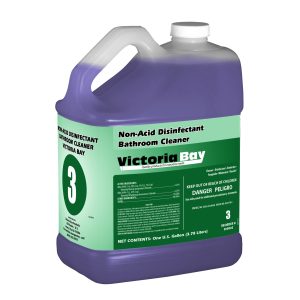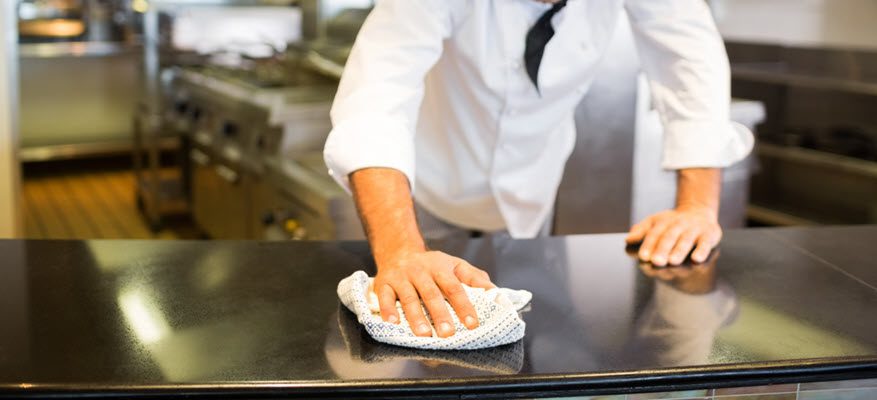Keeping any area clean and free of illness-causing germs and bacteria is important for businesses of all types, but it is especially critical in foodservice operations and other businesses that serve food.
Businesses serving food must lower the risk of cross-contamination and foodborne illness to keep guests protected from sickness.
Cleaning and sanitizing are essential to keeping your foodservice operation safe.
Soils, chemicals, germs and other contaminants left on surfaces increase the risk of infection, especially if food can potentially come into contact with these surfaces.
When food comes in contact with unclean surfaces, it risks picking up germs and transferring them to the person consuming the food.
With routine cleaning and sanitizing procedures, you can help maintain the safety of your foodservice operation and lower the risk of illness.
To clean and sanitize food contact surfaces, you’ll need a food grade, sometimes called food safe, sanitizer.
For the health and safety of your guests, you can not use a sanitizer unless it has been approved for food contact surfaces in these areas. Using a non-food grade sanitizer on a food contact surface could otherwise result in guest illness. In some cases, the sanitizer can even be poisonous if consumed.
A food contact surface is any surface, tool or piece of equipment that comes into contact with food, either directly or indirectly.
In a business that serves food, many focus on keeping the kitchen area clean to prevent germ spread. However, germs and bacteria can be found everywhere in a foodservice setting especially on countertops, dining tables, seats, sinks, transport carts, and more.
Germs found on these surfaces can easily be transferred by hand-to-hand contact or hand-to-food contact when it is then ingested by customers, potentially leading to illness or foodborne sickness.
Common bacteria that can spread in a foodservice setting and lead to illness and foodborne sickness include:
- E. coli
- Listeria
- Norovirus
- Salmonella
- Staphylococcus aureus (food poisoning)
- Common Cold
- Flu
To kill germs, there are two types of products: disinfectants and sanitizers.
Disinfectants are most effective at killing germs, but they are not approved for use in food contact areas.
Sanitizers, on the other hand, can be approved for use in food prep areas and on food contact surfaces however NOT ALL sanitizers are approved for food contact areas.
Pro Tip: Sanitizers are pesticides. In the United States, pesticides are regulated by the U.S. Environmental Protection Agency (EPA). Before using sanitizers on food contact surfaces, check to confirm the label includes an EPA registration number and then follow all label directions.
Sanitizing is the process of decreasing the number of microorganisms to a safe level. The sanitization standard for contamination reduction of food contact surfaces is generally accepted as 99.999%.
Pro Tip: While sanitizers are effective at killing germs, they can not be used to clean and remove soils or dirt from surfaces.
In order for a sanitizer to be effective at killing germs, a surface must first be cleaned of any soil load and then rinsed to remove any residue. Any soil, grease, or dust on a surface will inactivate sanitizers, rendering them ineffective at germ removal.
Additionally, there is a common misconception that strong, harsh sanitizers are the best option for food contact surfaces given the importance of germ removal. However, this is not only inaccurate, but it can also be hazardous. This is because sanitizing chemicals can contain toxins that present potential health risks to consumers if accidentally consumed.
Warning: Only use sanitizers that are approved for use on food contact surfaces based on the label information. Not all sanitizers are designated safe for use on food contact surfaces.
What Is Food Grade Sanitizer?
Food-grade, sometimes referred to as food-safe, sanitizers have been tested and certified safe for food contact. This means that even if the sanitizer comes into contact with food, it will not be harmful when ingested.
Sanitizers that have not been approved for food contact should not be used in food prep or food contact areas. Remember, these can be toxic if ingested.
Pro Tip: To determine if a sanitizer is safe for food contact surfaces, check the sanitizer label. If you are still not sure, reach out to the manufacturer or look for an EPA registration number.
Food Safe Sanitizer Products
There are several sanitizing chemical compounds approved for use on food contact surfaces.
Approved sanitizers for use on food contact surfaces include products with the following active ingredients:
- Hypochlorites
- Chlorine Dioxide
- Iodophors
- Peroxyacetic Acid (PAA)
- Quaternary Ammonium (quats)
Regardless of the chemical, the solution must be diluted to a specific concentration to ensure maximum efficacy.
Too little sanitizer can result in unacceptable efficacy, while too much sanitizer can yield residues that do not meet regulations imposed by the FDA (Food and Drug Administration).
Below, we’ll review the different chemicals used in sanitizers and what the desired concentration is for efficacy and safety.
Hypochlorites
Hypochlorite-based sanitizers are the most common and widely used food-safe sanitizers. They are low cost and effective making them the most popular choice.
Of the hypochlorite sanitizers, sodium hypochlorite is the most common compound.
Recommended Concentration:
The maximum allowable concentration is 200 ppm. Always follow the manufacturer’s label for dilution instructions.
Disadvantages:
While hypochlorites are very effective, the efficacy of the product is easily impacted by leftover soils on the surface, high temperatures, and improper pH levels.
For the greatest germ kill, surfaces must be thoroughly cleaned before sanitizing. They should be as free as possible of any residues and soils.
Additionally, spores, like Clostridium perfringens, are resistant to hypochlorites.
A final disadvantage of hypochlorites is the corrosiveness to metals. This product can damage surfaces if it is not used according to the manufacturer’s directions.
Chlorine Dioxide
Another common food-safe sanitizer is chlorine dioxide.
The U.S Food and Drug Administration and European regulatory agencies approve the use of chlorine dioxide in food processing and food service operations where food may come into contact with a surface.
This compound is a broad sanitizer effective against bacteria, fungi and viruses.
Compared to hypochlorites, chlorine dioxide requires much lower concentrations.
Recommended Concentration:
It is effective as a sanitizer with 100 ppm. Always follow the manufacturer’s label for dilution instructions.
Disadvantages:
Chlorine dioxide is unstable as a gas and is explosive in concentrations greater than 10%.
It must not be stored in the heat and should never be mixed with other chemicals.
Iodophors
Iodophors are another type of food-safe sanitizer.
These compounds are less active than hypochlorites and Chlorine Dioxide sanitizers but are still very effective.
Recommended Concentration:
The required concentration for sanitization is 25 ppm. Always follow the manufacturer’s label for dilution instructions.
Disadvantages:
Iodine compounds easily stain many surfaces, especially plastics. They are better used on glass or impervious items.
Peroxyacetic Acid (PAA)
PAA is an effective sanitizer that is active against many bacteria, fungi, and spores. This is also one of the most effective food-safe sanitizers in removing biofilms.
There are two types of PAA: acetic aid and hydrogen peroxide.
Unlike other sanitizers, PAA sanitizers function well under cold conditions.
PAA-based sanitizers are environmentally friendly as the compounds break down into acetic acid, oxygen and water. These sanitizers are also less corrosive to equipment than hypochlorites.
Recommended Concentration:
To be effective, they should be concentrated at 100 ppm to 200 ppm for peroxyacetic acid and 80 ppm to 600 ppm for hydrogen peroxide. Always follow the manufacturer’s label for dilution instructions.
Disadvantages:
The efficacy of PAA solutions is greatly reduced if there are any leftover soils on a surface. The surface will need to be thoroughly cleaned to remove any residues before use.
This is a highly active oxidizer and can present a safety hazard if it comes into prolonged contact with skin.
Quaternary Ammonium Compounds (Quats)

The last food-safe sanitizer we will cover are quats. Quats are effective against a wide range of germs and bacteria.
Quats are usually odorless, nonstaining, and noncorrosive. They also function well in a broad temperature range.
Recommended Concentration:
Quats may be applied at concentrations varying from about 100 ppm to 400 ppm. For use as a food safe sanitizer, quats should be applied at 200 ppm. Always follow the manufacturer’s label for dilution instructions.
Unique to quats, once the solution dries, a residue of the compounds remains and provides germicidal activity until degradation occurs.
Disadvantages:
Heavy soil will decrease efficacy significantly.
Quat-based sanitizers should be used with the appropriate procedures and tools to avoid quat-binding.
Pro Tip: What is quat binding? Check out this short video:
Final Thoughts
In any facility serving food, sanitizing surfaces is key to infection prevention and lowering the risk of cross-contamination.
Sanitizing helps ensure the foods produced and consumed do not come into contact with any illness-causing germs or other harmful microorganisms.
Always select a sanitizer that is approved for use on food contact surfaces based on the label information. If you are not sure, the manufacturer is a good resource when determining whether a specific sanitizer is safe for your operation.
It will also be important to properly dilute the sanitizing chemical to ensure germ removal and guest safety.
Imperial Dade locations have a wide range of food-grade sanitizers that can help increase safety for your customers. Whether you’re located in the United States, Puerto Rico, the Caribbean, or Canada, we can help you decide what the best sanitizer is for your foodservice facility.
If you have any questions about sanitizing food contact surfaces, reach out to a specialist today!
